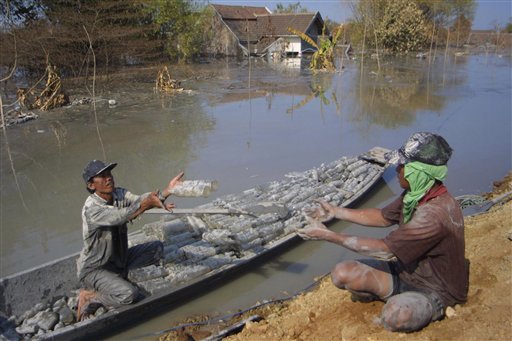 This week Indonesia began dumping mud surging from a gas exploration site in central Java into the sea in a desparate effort to minimise destruction from the disaster that has submerged entire villages and displaced thousands. The "mud volcano" pours out some 120,000 cubic metres of mud every day. Experts say the mud volcano is one of the largest ever recorded on land. Geologists fear the technology may not exist to stop the eruption, saying mud could flow for years or even centuries. In short, no one knows when it might stop.
This week Indonesia began dumping mud surging from a gas exploration site in central Java into the sea in a desparate effort to minimise destruction from the disaster that has submerged entire villages and displaced thousands. The "mud volcano" pours out some 120,000 cubic metres of mud every day. Experts say the mud volcano is one of the largest ever recorded on land. Geologists fear the technology may not exist to stop the eruption, saying mud could flow for years or even centuries. In short, no one knows when it might stop. The sludge has been spewing out of the ground since 28 May. It was probably caused by human error. The gas company Lapindo Brantas were drilling a 3km deep exploratory well looking for natural gas. The well cracked and unleashed a torrent of mud. Lapindo have been criticised for risking the safety of local people. There are also allegations of corruption. Jakarta launched a criminal investigation focussing on senior executives from Lapindo and one of their sub-contractors. The company's lawyer said they had done nothing wrong. The company is 60% owned by the Bakrie Group belonging to government Coordinating Minister for the People's Welfare Aburizal Bakrie and his brothers. According to Forbes, Bakrie and his family are the sixth richest in Indonesia with a net worth of $1.2 billion.
The Indonesian news agency Antara reported that Greenpeace staged a rally in which demonstrators dumped Lapindo mud near the entrance to the minister’s office. The protesters conducted a silent protest while raising a banner saying "Stop your mud, Bakrie, or your mud will stop you." Last month Bakrie sold Lapindo to a Jersey off-shore entity called Lyte Limited in September. Although Lyte is owned by Bakrie, the object was to avoid responsibility if Lapindo goes bankrupt as a result of the disaster.
The mud is coming from a reservoir 6km below the surface. It has been been pressurised by shifts in the crust or possibly by the accumulation of hydrocarbon gases. Every day, up to 150,000 cubic metres of mud continues to spurt from a large crater. The mud has forced more than 13,000 people to flee from their homes near Indonesia’s second largest city of Surabaya. The thick sludge has now spread over 400 hectares, swallowing eight entire villages, acres of rice paddy fields, numerous factories, and forced the closure of a major toll road for weeks.
 The Jakarta government recently gave permission to dump the mud into the sea via a river. But experts question whether that will get rid of the sludge faster than it gushes from the hole. Environmentalists are also opposing the plan as a threat to the marine ecosystem. Australian company Century Resources has been engaged to drill one of two relief wells at the site, and they are hopeful the operation will stop the mudflow "around" the end of the calendar year. The displaced population has been given temporary shelter. Indonesian President Susilo Bambang Yudhoyono has authorized further flow of mud to be be pumped into the Porong River that will take it to the local sea. Pumping of sludge into the sea started on 16 October. The ultimate cost of raping the Earth in one of its most active seismological zones remains unknown.
The Jakarta government recently gave permission to dump the mud into the sea via a river. But experts question whether that will get rid of the sludge faster than it gushes from the hole. Environmentalists are also opposing the plan as a threat to the marine ecosystem. Australian company Century Resources has been engaged to drill one of two relief wells at the site, and they are hopeful the operation will stop the mudflow "around" the end of the calendar year. The displaced population has been given temporary shelter. Indonesian President Susilo Bambang Yudhoyono has authorized further flow of mud to be be pumped into the Porong River that will take it to the local sea. Pumping of sludge into the sea started on 16 October. The ultimate cost of raping the Earth in one of its most active seismological zones remains unknown.
No comments:
Post a Comment